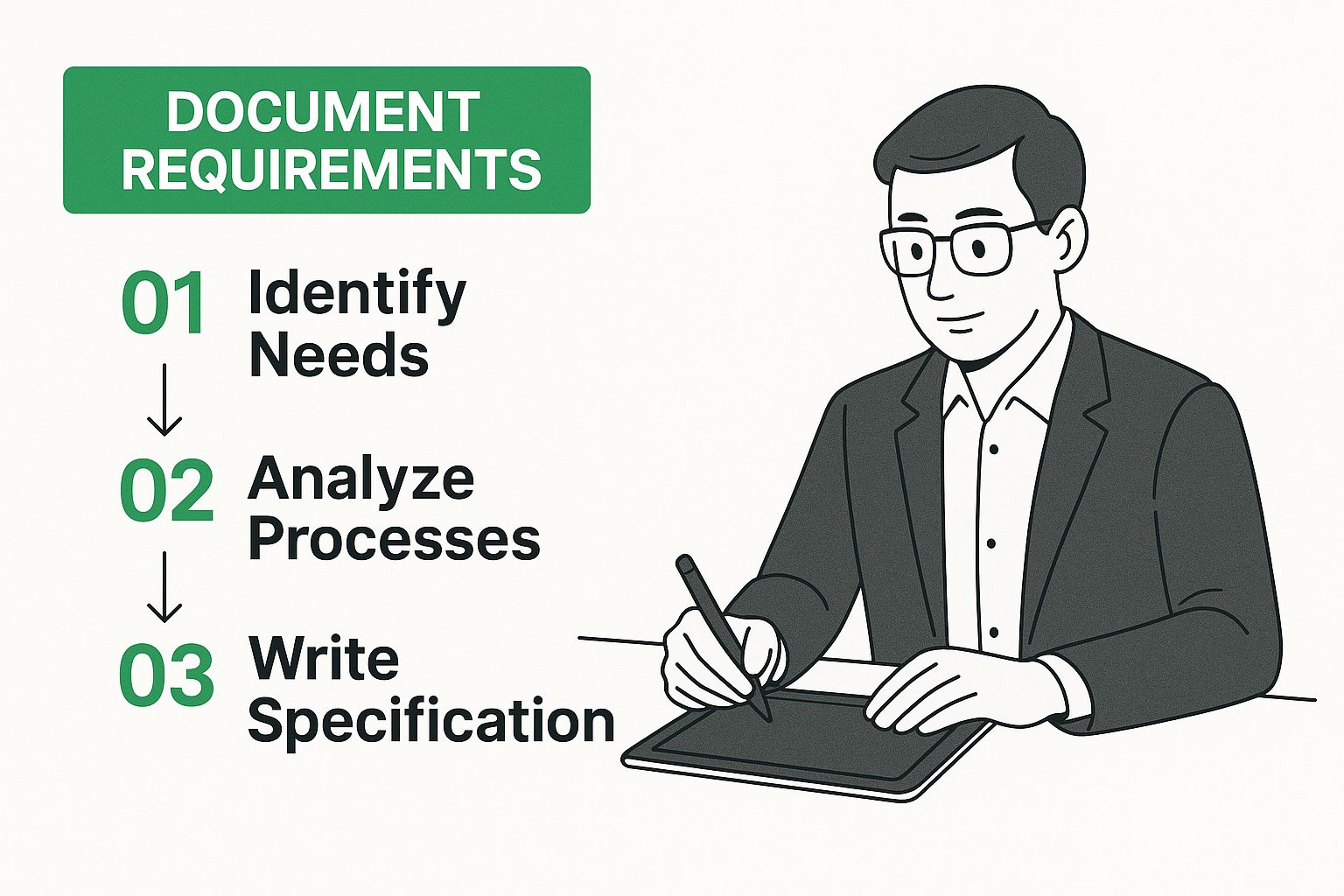Learn how to write business requirements that prevent scope creep and ensure project success. A guide with real-world examples and actionable tips.
Writing good business requirements is all about translating what the business needs into a clear, actionable roadmap for your development team. Get this right, and you’ve built your best defense against the usual project killers: scope creep, blown budgets, and total stakeholder chaos.
It’s the art of turning a vague, “we need a better system,” into precise instructions that set your project up to win from the very beginning.
At its heart, a business requirement document explains the “what” and the “why” behind a project—never the “how.” That’s for the technical team to figure out. This document becomes the single source of truth that gets everyone on the same page, from the execs signing the checks to the developers slinging the code.
When you don’t have that alignment, people start working off assumptions. And that’s a fast lane to project failure.
In fact, poorly defined requirements are the number one reason projects go off the rails. Some studies have shown that a staggering 70% of project failures trace back to this one fundamental misstep. On the flip side, organizations that get this right see their project success rates jump by 40%. You can dig deeper into the data by checking out the full research on requirement documentation.
Think of your business requirements like the blueprints for a skyscraper. You wouldn’t just start pouring concrete without a detailed plan showing every floor, beam, and electrical outlet, right? You’d end up with a structurally unsound mess that doesn’t do what it was supposed to.
Solid requirements do the same for your software project, ensuring what you build is stable, functional, and actually solves the business problem.
Here’s what that looks like in practice:
Before we dive into how to write them, let’s break down the essential pieces that make a requirement strong. A solid requirement isn’t just a sentence; it’s a bundle of information that gives your team everything they need.
This table gives you a quick look at the core elements that ensure every business requirement is clear, complete, and actionable for your team.
Getting these components right for every requirement is what transforms a simple wish list into a professional, executable plan.
One of the most vital jobs of a business requirement is to create a common language. Business leaders think in terms of problems, revenue, and customer satisfaction. Technical teams think in terms of databases, APIs, and algorithms. A well-written requirement acts as the translator.
This is absolutely crucial in modern development. If you’re working in fast-paced, iterative cycles, you have to balance detailed planning with agility. Our guide on documentation in agile development dives into that specific challenge.
Ultimately, learning how to write killer business requirements isn’t just a documentation skill—it’s a core competency of project leadership. It’s how you steer the ship instead of just letting it drift.
Right, before you even think about writing a single requirement, you have to put on your detective hat. Your first job is to figure out who you need to talk to and then pull the critical details out of them. This isn’t just about sending out a survey asking, “What do you want?” It’s about some real investigative work to uncover the problems that are actually worth solving.

The first piece of the puzzle is identifying your stakeholders. This is anyone and everyone who has a stake in the project or will be touched by its outcome. You’ve got the obvious ones, like your project sponsor and the people who will use the final product every day. But don’t forget the folks operating in the background—the support team who will have to deal with tickets post-launch, or the legal department that needs to ensure everything is compliant. Missing a key stakeholder early on is a classic mistake that almost guarantees a major, project-derailing surprise down the road.
Once you have your list of who to talk to, you need a plan for how you’re going to talk to them. Different scenarios demand different approaches. Getting this right means you’ll get better information, and you won’t waste anyone’s time.
Think of these as different tools in your toolkit. An interview might surface a critical problem from one person’s perspective, and a workshop helps the whole group decide on the best way to tackle it.
The quality of your business requirements will only be as good as the questions you ask. You have to get past the surface-level requests. Your real job isn’t to be a stenographer for what stakeholders say they want; it’s to uncover the why behind their requests.
Just think about the difference. A simple request for a “new report button” can quickly become a much more revealing conversation about the 10 hours someone wastes every single month manually pulling data together. Suddenly, you realize the real need isn’t a button—it’s getting automated, accessible data to save time and prevent errors.
Here’s how that looks in practice:
The best questions are open-ended. They encourage people to tell stories, and in those stories, you’ll find the rich context you need to write requirements that actually matter.
On any project worth doing, you’re going to hit conflicting priorities. It’s inevitable. Finance might be pushing for security protocols so tight that the sales team sees them as a major barrier to getting their work done quickly. Your job here is to be the neutral facilitator. You need to document both sides objectively and, if necessary, get the decision-makers in a room to negotiate. The end goal isn’t to make one department happy; it’s to find the path that best serves the overall business objective.
Of course, sometimes the problem isn’t conflict, it’s crickets. Getting an unresponsive stakeholder to engage can be tough, but it’s crucial because their silence could be hiding a critical piece of information. If your emails are going into a black hole, switch up your tactics.
By being systematic about how you gather this intelligence, you build a rock-solid foundation. This early work is what separates a flimsy wish list from a powerful set of requirements that can actually guide a project to a successful launch.

A top-notch Business Requirements Document (BRD) is so much more than a wishlist. It’s the story of your project, guiding everyone from the initial idea to the final product. Your job is to take all the insights you’ve pulled from stakeholders and weave them into a clear, logical narrative that leaves no room for confusion.
Think of the BRD as the project’s constitution. Each section logically flows into the next, creating a complete picture of the problem, the solution you’re proposing, and exactly what success looks like. Let’s walk through the anatomy of a professional BRD, piece by piece, so you know how to build this critical document.
Every BRD needs to kick off with a sharp, concise executive summary. This isn’t the place for a long, rambling intro. It’s the high-level snapshot for busy executives and stakeholders who need to get the gist of the project in less than 60 seconds.
Your summary has to nail down the business problem, the solution you’ve landed on, and the value it’s expected to deliver. It sets the entire stage, making sure anyone—technical or not—understands why this project even exists.
Right after the summary, you have to draw your lines in the sand with the project’s objectives and scope. This section is your single best defense against the dreaded scope creep. The objectives are your big-picture goals, the things that tie directly back to business value. For instance, an objective could be “to cut down customer support call volume by 25% within six months of launch.”
The project scope then gets specific. It spells out exactly what is in-scope (the features and deliverables you’re committing to) and, just as critically, what is out-of-scope. Being crystal clear about what you are not doing is a lifesaver for managing expectations down the road.
This is where the real meat of your BRD lives. Functional requirements describe the specific things the system has to do. They define what the system will do from the user’s point of view. Each one needs to be clear, direct, and impossible to misinterpret.
For example, don’t just write “Users should be able to manage their profile.” That’s too vague. Break it down into concrete, testable actions:
See the difference? Each statement is something a developer can build and a tester can verify. There’s no wiggle room.
If functional requirements are about what the system does, non-functional requirements (NFRs) are all about how it does it. These are the quality standards that make sure the system is actually usable, secure, and reliable. Ignoring NFRs is a rookie mistake that creates products that technically “work” but are a nightmare for users.
Some key NFRs you can’t afford to forget include:
To make sure every requirement lands with impact, run it through the SMART framework. Every single requirement, whether it’s functional or non-functional, has to be:
Sticking to this structure isn’t just about ticking a box; it has a real impact. Companies that use structured business requirement specs, including clear data definitions, see a 35% improvement in hitting project deadlines and a 28% reduction in bugs after launch. You can dig deeper into the importance of clear data requirements to see how it truly shapes project outcomes.
Right, you’ve gathered your intel and laid out the skeleton of your document. Now comes the part that makes or breaks the entire project: writing the actual requirements. This is where precision isn’t just a nice-to-have; it’s your most critical asset.
I can’t tell you how many projects I’ve seen go off the rails because of a single, poorly worded requirement. It’s the number one cause of confusion, endless rework, and features that, when finally delivered, look nothing like what the business actually needed. Honestly, learning to write with absolute clarity is what separates a good analyst from a truly great one.
The goal is simple but challenging: write a statement so precise that two different developers could read it and build the exact same thing. A tester should be able to look at your requirement and know precisely what to test—without having to hunt you down for clarification. It’s all about surgically removing every last bit of ambiguity.
This is where you, the analyst, translate all those conversations and stakeholder wishes into a concrete blueprint for the tech team.

One of the most powerful tricks I’ve learned for achieving this level of clarity is to change my perspective. It’s a simple mental shift. Instead of writing from a dry, system-focused view (“The system must be configured to…”), I write from the user’s point of view. This little change forces you to think about the real people who will use this feature and what they actually need to accomplish.
This is the very soul of user stories, a format that’s become incredibly popular in Agile teams for good reason. A user story follows a simple, elegant template:
This structure is brilliant because it wraps the “who,” “what,” and “why” into a single, easy-to-digest sentence. It keeps the entire team focused on delivering genuine value. For example, a vague, technical requirement like “Implement search functionality” becomes much more powerful as a user story: “As a customer, I want to search for products by name so that I can find what I’m looking for quickly.” See the difference?
For more complex features, a single user story might not cut it. That’s when you need to bring in the heavy hitters: use cases and process flow diagrams. A use case digs deeper, providing a step-by-step narrative of how a user interacts with the system to hit a specific goal. It covers the primary success path, but also important detours like alternative flows and error handling.
And sometimes, a picture really is worth a thousand words. When a process has multiple steps, decision points, and hand-offs, a visual process flow diagram can explain the logic far better than a wall of text. It gives everyone—from stakeholders to developers—an instant, at-a-glance understanding of the entire workflow. This makes it much easier for people to spot issues and give their sign-off.
The absolute biggest enemy of a clear requirement is fuzzy, ambiguous language. I’m talking about words like “fast,” “easy,” “intuitive,” and “user-friendly.” These words are poison because they’re completely subjective and impossible to test. What you consider “fast,” your lead developer might see as painfully slow.
Your job is to hunt down these weasel words and replace them with specific, measurable criteria.
This is the core discipline of effective requirements writing. You’re turning a vague wish into a concrete, testable directive. You’re defining exactly what “done” and “successful” look like.